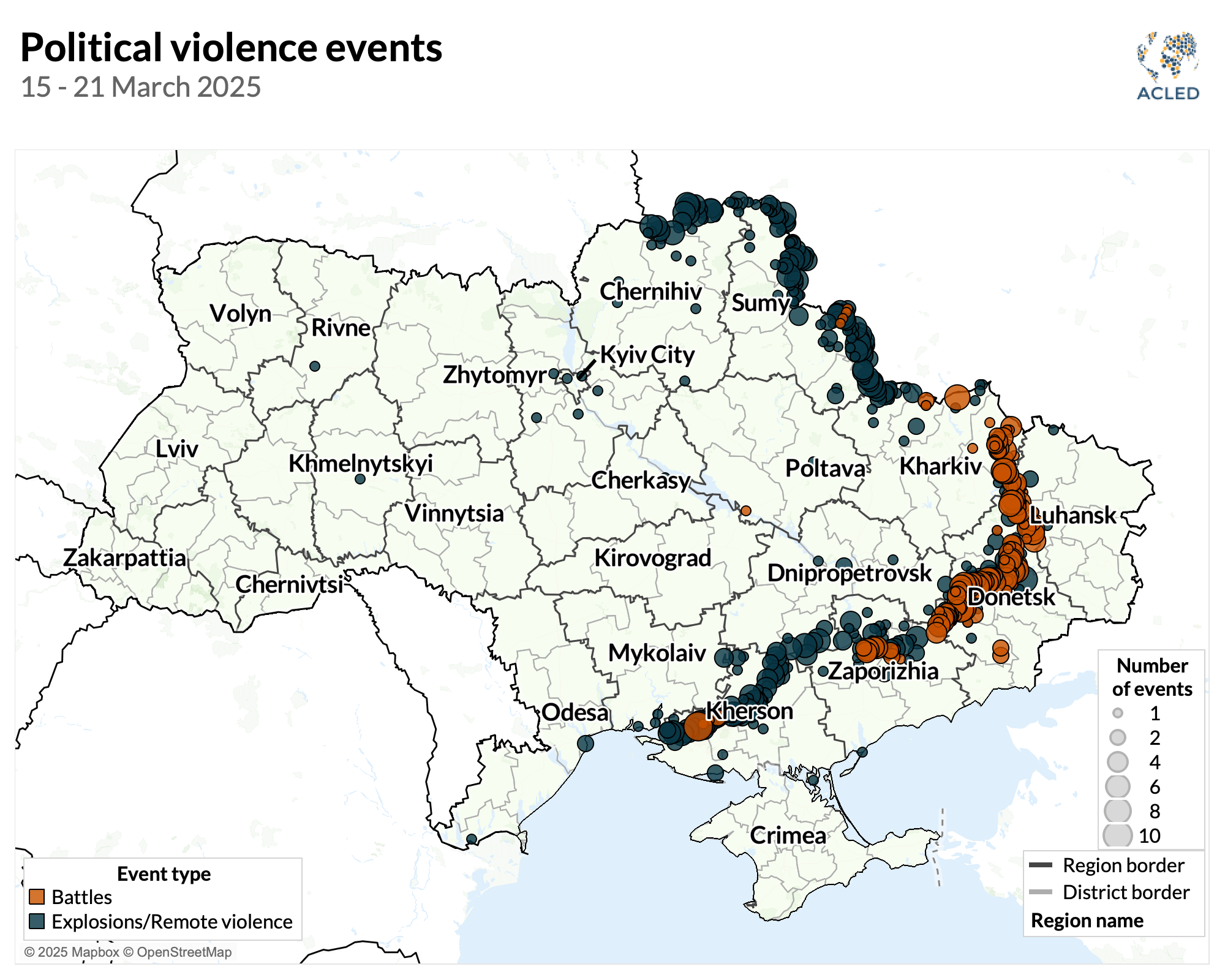Key trends
- In the Donetsk region, Russian forces seized a village southwest of Pokrovsk. Russian forces also advanced near Velyka Novosilka and northeast of Lyman.
- Russian forces occupied two settlements west of Orikhiv in the Zaporizhia region and advanced northeast of Dvorichna in the Kharkiv region.
- ACLED records 17 Russian long-range missile and drone strikes, including in the Kyiv region and Kyiv city. Ukrainian forces intercepted strikes in at least 40 other instances in 15 regions, including in the western region of Khmelnytskyi.
- Russian shelling, missiles, and drones killed at least 24 civilians in the Dnipropetrovsk, Donetsk, Kharkiv, Kherson, Sumy, and Zaporizhia regions.
Key events
- 19 Mar. | Chernihiv – Ukraine and Russia swap 350 prisoners of war
- 20 Mar. | Kirovohrad – Russian drones wound 14 civilians and damage 87 residential buildings in Kropyvnytskyi
- 21 Mar. | Zaporizhia – Russian drones strike a residential building in Zaporizhia, killing three civilians and wounding 16 others
Spotlight: Strikes on energy infrastructure continue despite the limited ceasefire
On 18 March, Ukraine and Russia verbally agreed not to target each other’s energy infrastructure for 30 days. This followed talks with the United States in which Russia refused the full unconditional 30-day ceasefire the US initially proposed.1Hanna Arhirova, “Zelenskyy and Putin have agreed to a limited ceasefire, but implementation is work in progress,” The Associated Press, 20 March 2025 Despite this, since 18 March, Russia and Ukraine have exchanged more than 20 strikes on energy infrastructure, of which some appear deliberate.
Less than an hour after the announcement, Russian glide bombs hit the railway power system in Slovyansk in the Donetsk region, causing blackouts in the city. This was followed by a “double-tap” strike targeting firefighters who arrived at the scene.2Kyiv Post, “Russian Strikes Hit Ukraine Mere Hours After Trump-Putin Ceasefire Talks,” 19 March 2025 The strikes on civilian energy infrastructure continued throughout the night, causing power outages, interrupting gas supply in other towns of the Donetsk region, and damaging a gas pipeline in the Sumy region. Later the same night, Ukrainian drones struck an oil depot in Russia’s Krasnodar region, causing a fire that lasted for several days. Russian strikes continued in the following days. A wave of drone attacks caused blackouts in Odesa city on 20 March. On 21 March, Ukraine and Russia accused one another of hitting a gas metering station near Sudzha in Russia’s Kursk region,3Kieran Burke, “Russian gas pumping facility ablaze after explosion,” Deutsche Welle, 21 March 2025 with Russia threatening continued attacks.4The Moscow Times, “Russia and Ukraine Trade Blame for Attack on Gas Pumping Station in Kursk Region,” 21 March 2025; Reuters, “Russia warns of ‘symmetrical response’ to Ukrainian attacks on energy facilities,” 22 March 2025
Russia has been systematically targeting Ukraine’s energy infrastructure since October 2022, inflicting significant hardship on civilians by causing blackouts and interruptions to the country’s heating and water supply. Ukraine has also been increasingly targeting Russia’s oil and gas facilities, focusing on facilities involved in exporting energy.
Explore the ACLED Conflict Exposure tool to assess the numbers of people affected by armed violence, disaggregated by locations, time period, and actors involved.





